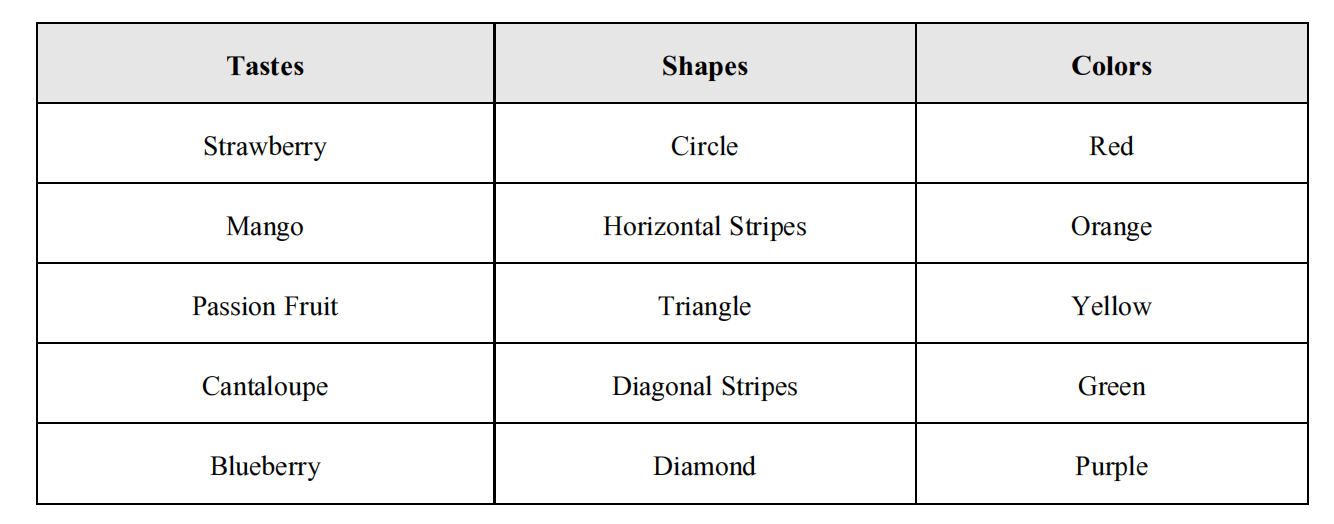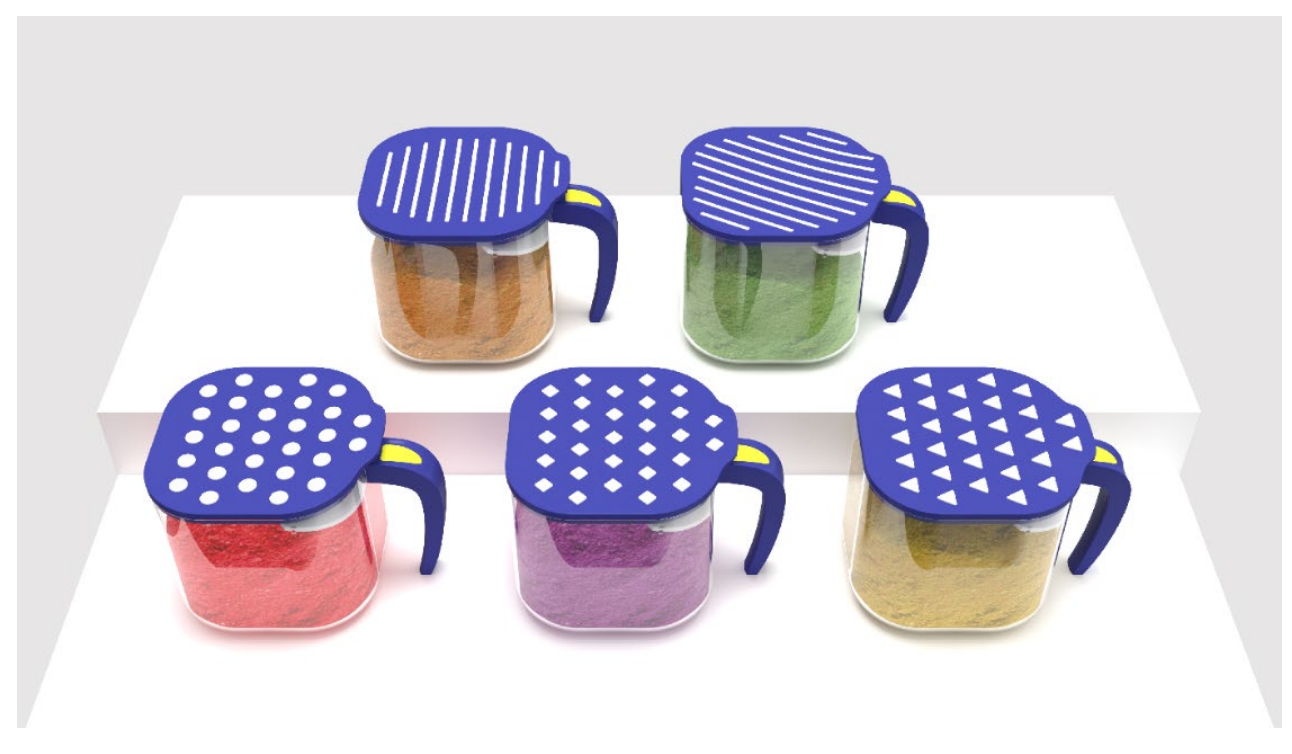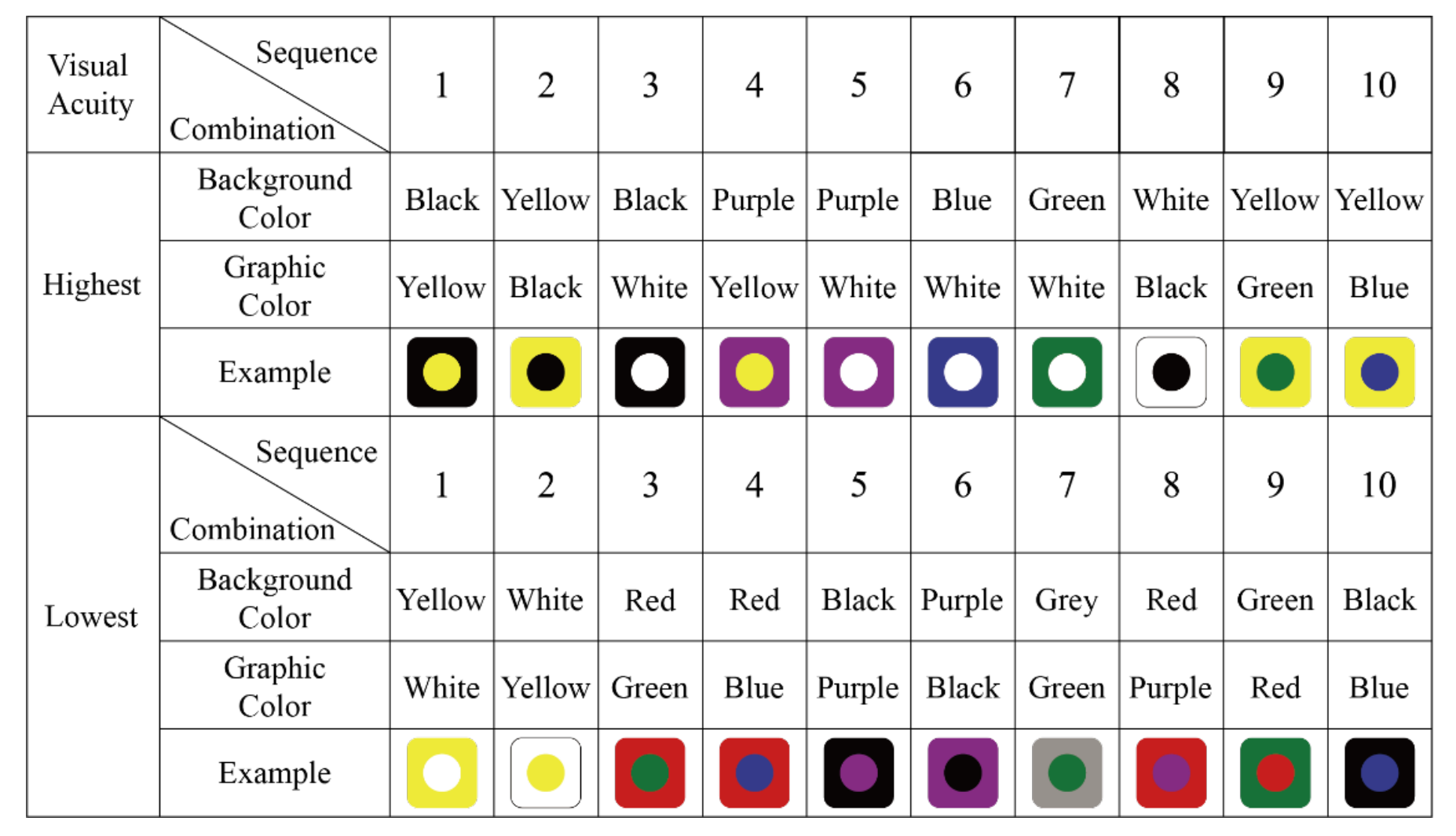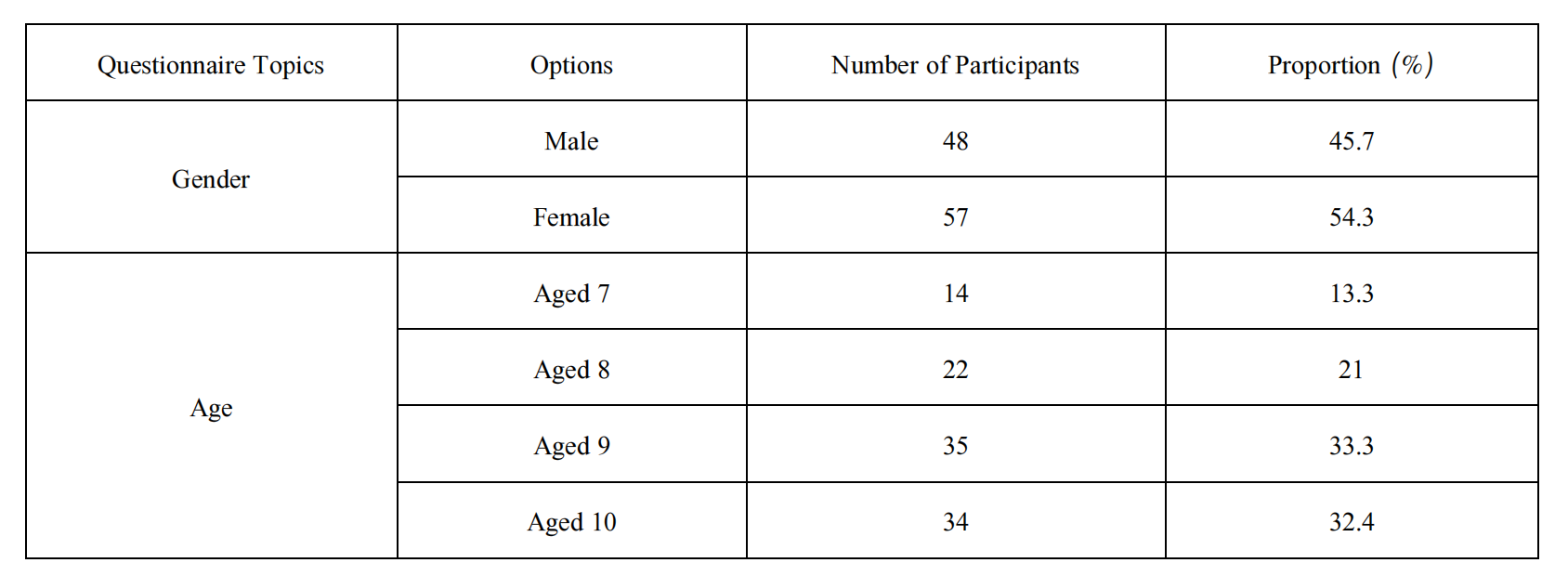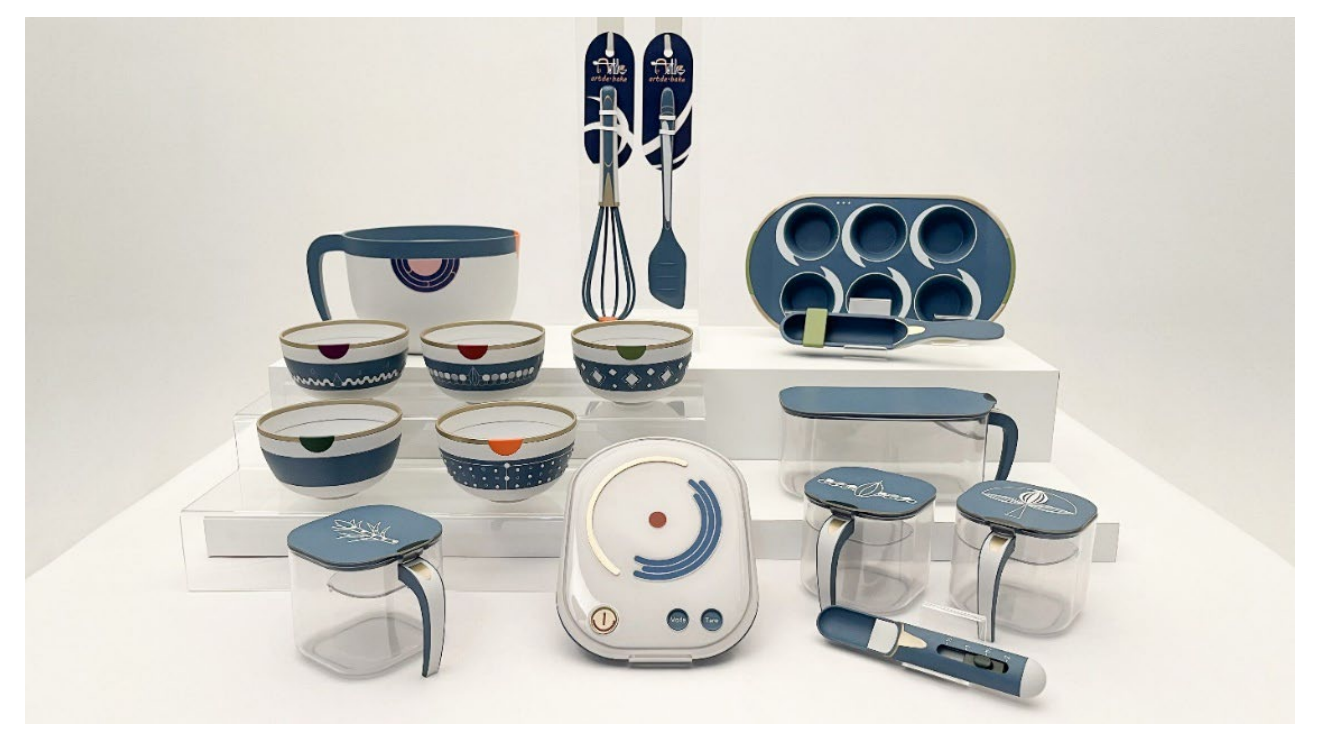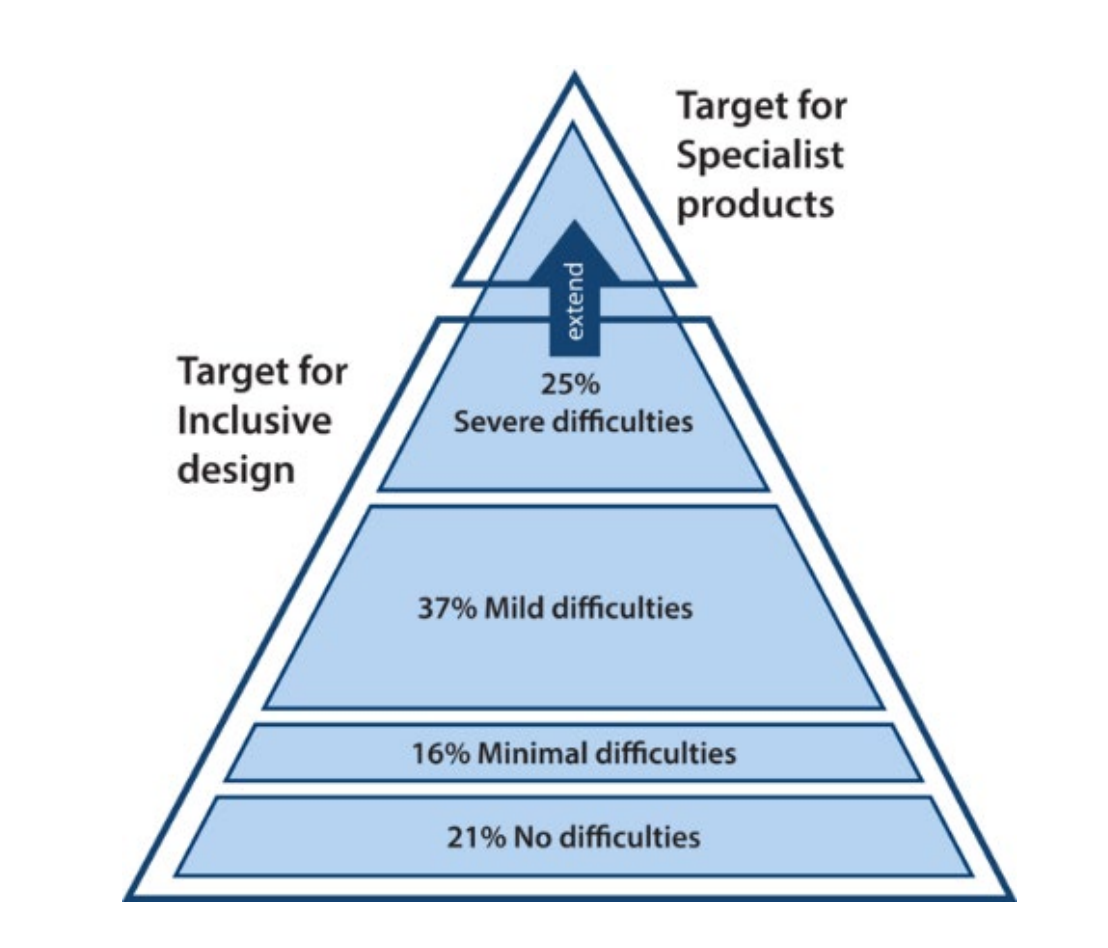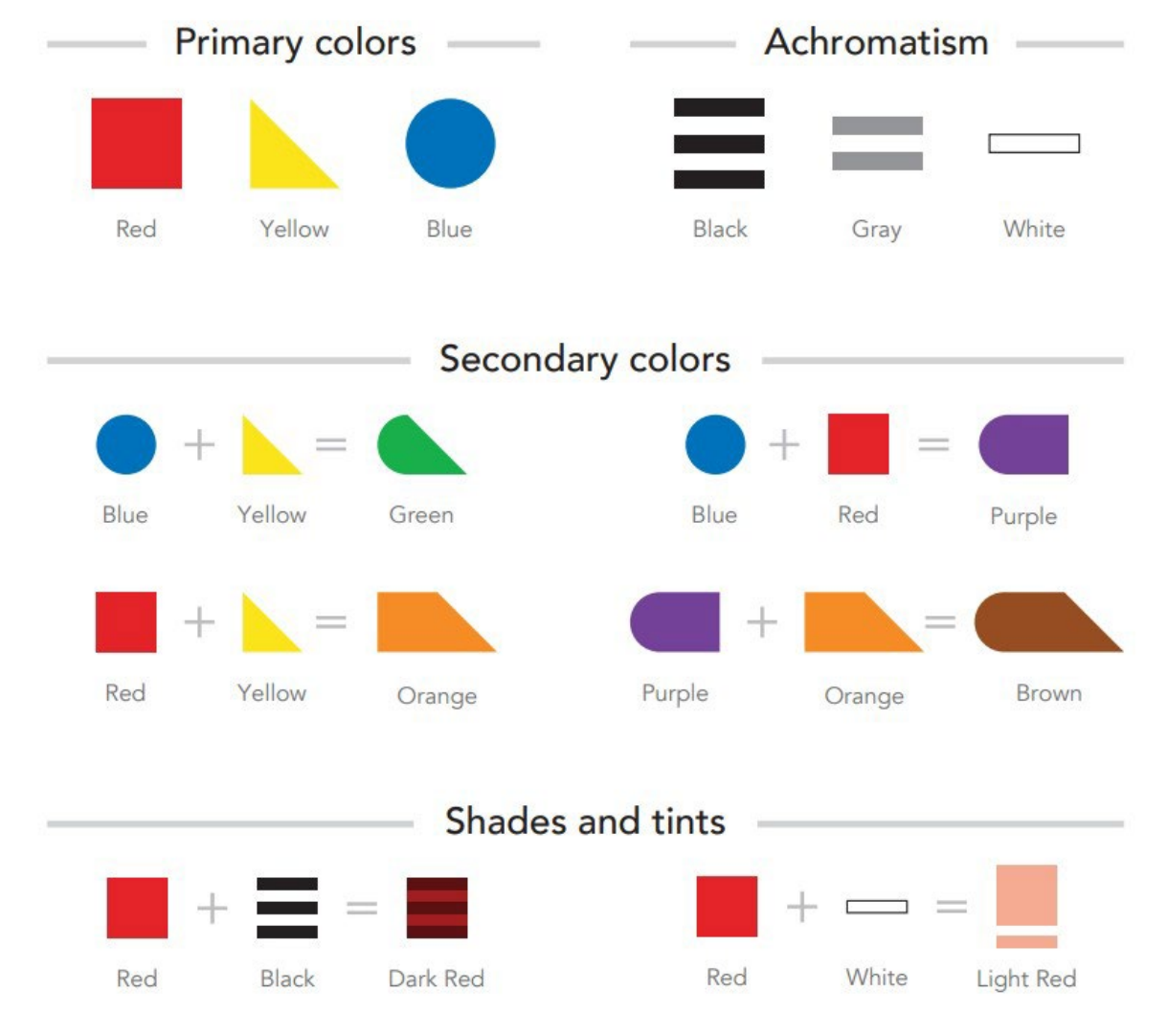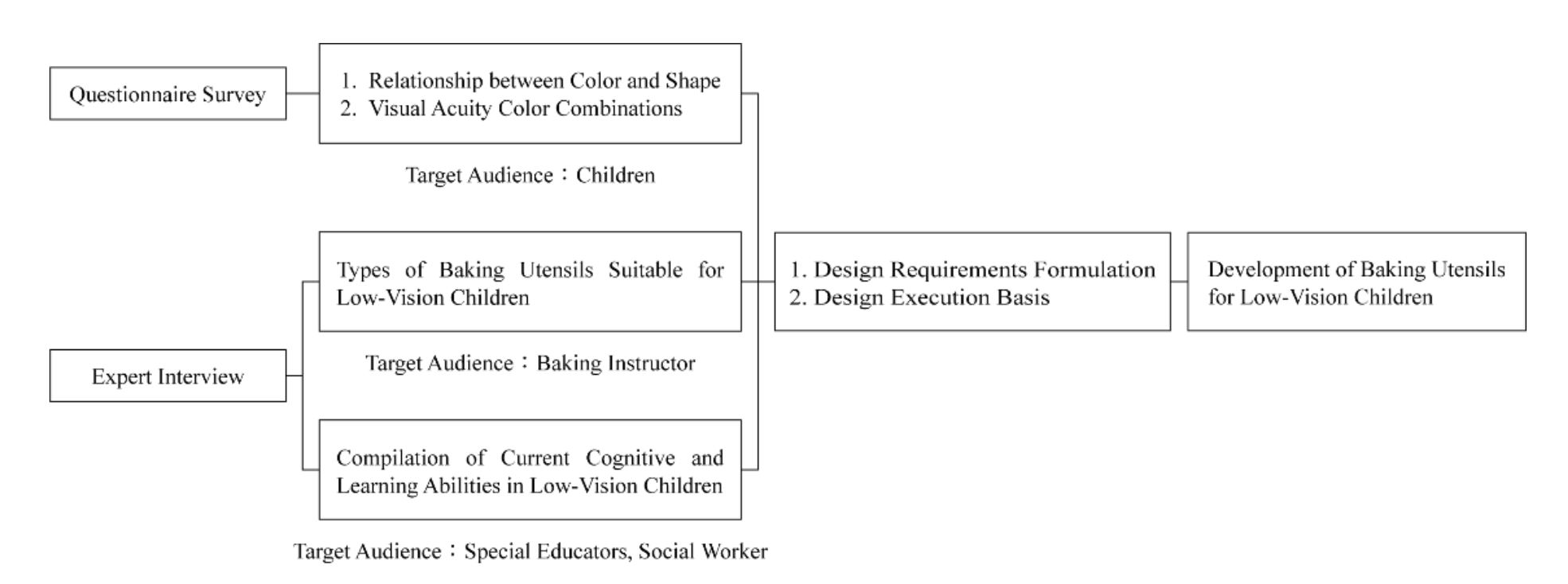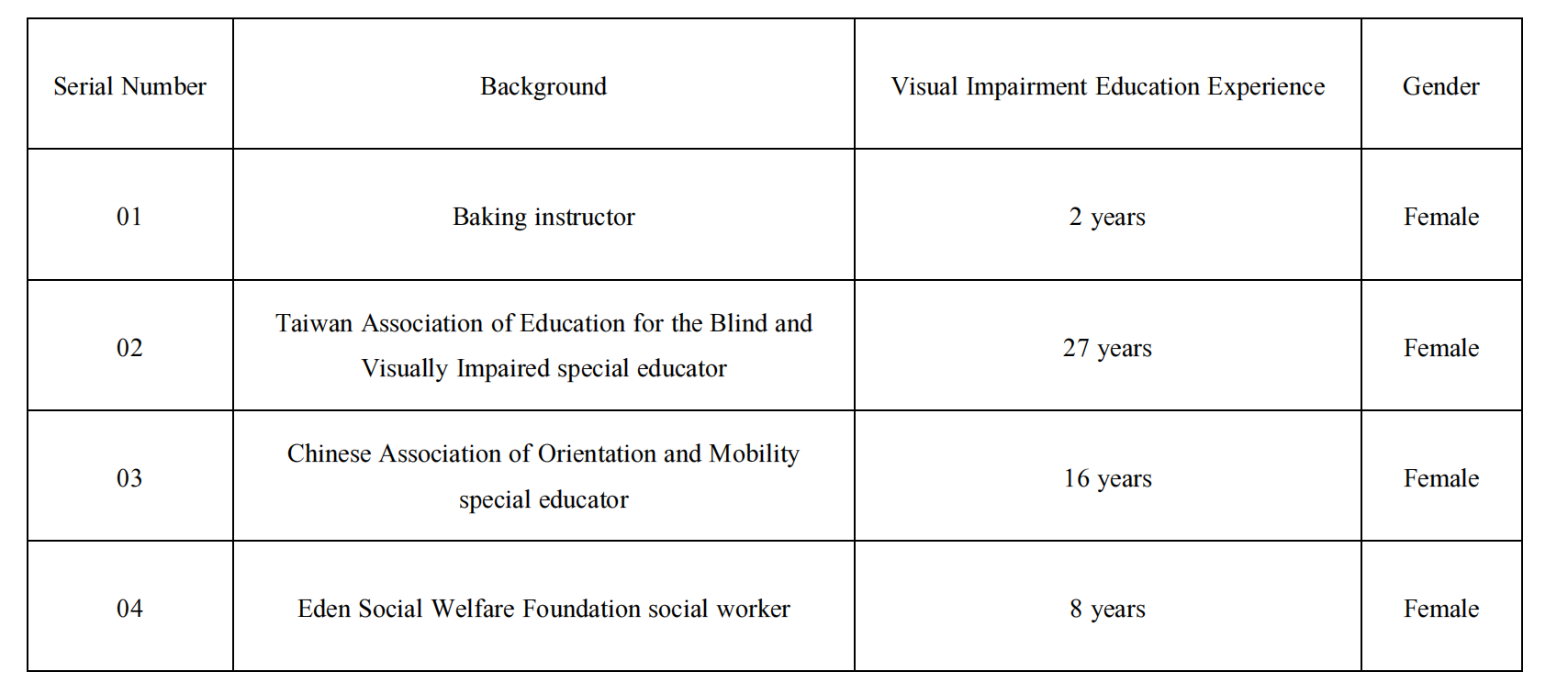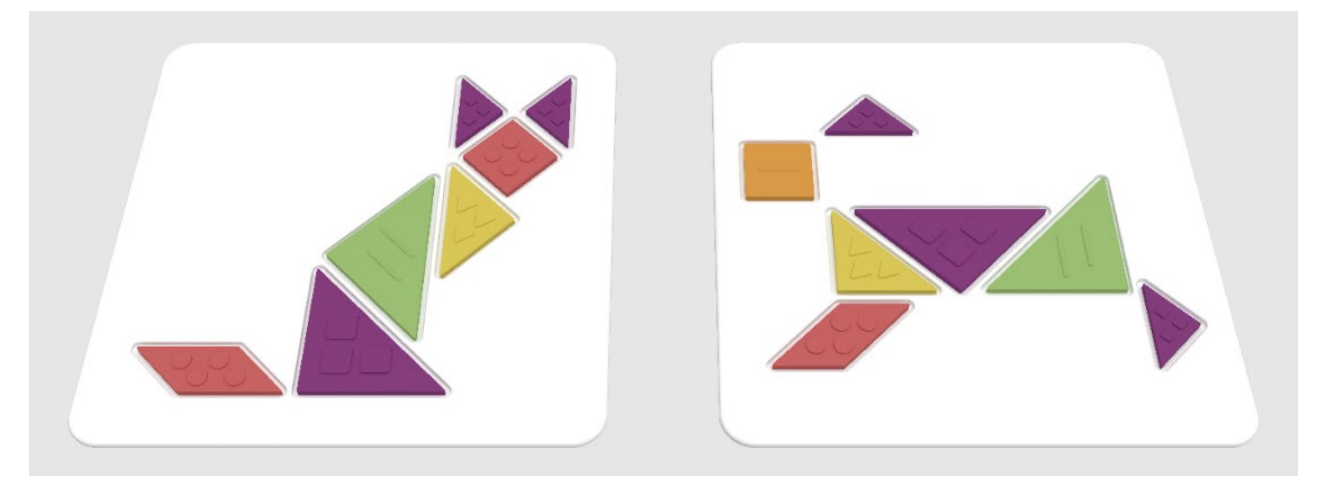Table 6. Tastes Corresponding Shapes and Colors (drawn by the authors)
Spatula
Embossed patterns not only provide tactile feedback but also offer auditory feedback, allowing low-vision children to engage in baking activities using both touch and hearing. Therefore, this study designs embossed stripes on the surface of the spatula, so that when low-vision children use the spatula to scrape dough off the edge of the mixing bowl, they can feel the resistance points and hear the feedback, giving them a sense of security during use. Additionally, since strong color contrasts can enhance visual acuity and color recognition in low-vision children, this study ensures that the color at the tip of the spatula is distinctly different from the colored dough, helping low-vision children recognize whether they have successfully scraped the dough (Figure 9).
Figure 8. Ingredient Containers Design (provided by the authors)
Mixing Bowl
Based on the considerations gathered from expert interviews regarding the design of baking utensils suitable for low-vision children, this study adjusts the size of the mixing bowl to be taller (Figure 10) to prevent contents from spilling out during mixing. The raised design of the base allows low-vision children to safely perform large-range mixing (Figure 11). To enhance the user experience, the spout is made of silicone material and uses another color, yellow, which also forms a high-visibility color combination with blue. This design not only improves visual recognition for low-vision children but also provides a clear reference point when pouring ingredients, making the operation more accurate. Additionally, considering the unsteady grip strength of children, the bottom of the mixing bowl is equipped with a silicone non-slip design to prevent significant movement during mixing, ensuring safety and stability during use.
Figure 9. Spatula Design (provided by the authors)
Share and Cite
Chicago/Turabian Style
Wan-Li Wei and Yishi Tan, "User-Centered Caring Design for Amblyopic Children to Achieve Life Equality and Pleasure." JDSSI 2, no.2 (2024): 24-41.
AMA Style
Wan-Li Wei and Yishi Tan. User-Centered Caring Design for Amblyopic Children to Achieve Life Equality and Pleasure. JDSSI. 2024; 2(2): 24-41.
Figure 11. Convex Bottom Design (provided by the authors)
© 2024 by the authors. Published by Michelangelo-scholar Publishing Ltd.
This article is published under the Creative Commons Attribution-NonCommercial-NoDerivs 4.0 International (CC BY-NC-ND, version 4.0) license (https://creativecommons.org/licenses/by-nc-nd/4.0/), which permits non-commercial use, distribution, and reproduction in any medium, provided the original work is properly cited and not modified in any way.
Questionnaire Survey
The questionnaire survey for this study focuses on children aged 7 to 10 years. It aims to explore their perceptions of the relationship between colors and shapes and their thoughts on visual acuity color combinations. To understand the colors and shapes relationship, this study refers to the tactile patterns developed by BVI in their “Tactile Colour System.” The data collected will serve as a basis for designing graphic aids for baking utensils. Additionally, for visual acuity color combinations, the study refers to both the highest and lowest visual acuity color combinations. This information will guide the color combination for subsequent baking utensil designs.
The questionnaire survey in this study was conducted through face-to-face interviews from September 27, 2023, to October 26, 2023. A total of 105 valid questionnaires were collected. Among them, 48 respondents were boys, and 57 respondents were girls, with a male-to-female ratio of 1:1.19. The age distribution included 14 children aged 7, 22 children aged 8, 35 children aged 9, and 34 children aged 10 (Table 2).
Table of Contents
- Abstract
- Introduction
- Literature Review
- Research Methods
- Analysis of Research Results
- Conclusion
- Acknowledgements
- Conflicts of Interest
- References
Development of Baking Utensils for Low-Vision Children
Based on the questionnaire and interview results, this study formulated design requirements and used the data as a reference for designing and developing baking utensils. The study focused on the 6 types of baking utensils listed above and proposed design concepts and concept screening. Finally, detailed design and prototype production were carried out.
This study focused on designing and developing baking utensils specifically for making cookies and categorized these utensils into two types: adapted original models and innovative designs, as shown in Table 5. The original model is a set of baking utensils designed for visually impaired individuals as part of a final-year graduation project. This set includes a measuring spoon, ingredient containers, ingredient bowls, a scale, a whisk, a spatula, a mixing bowl, a scoop, and cupcake molds, as shown in Figure 7. Since this set of baking utensils was tailored for cupcake baking processes, this study focuses only on adjusting the baking utensils needed for cookie-making. These adjustments include ingredient containers, spatulas, and mixing bowls, while the rolling pin has been modified based on existing products. For innovative designs, the study focuses primarily on developing products related to cookie molds and shaped silicone mats.
Conclusion
This study investigates the relationship between sensory product design and inclusive design based on research background and objectives. Additionally, it draws upon relevant literature regarding low vision and the cognitive and learning abilities of visually impaired children to inform the development of questionnaires and interview guidelines. Subsequently, by collecting 105 valid questionnaires, the study summarizes children’s perceptions of the association between colors and shapes and their thoughts on visual acuity color combinations. Furthermore, semi-structured interviews with four experts were conducted to understand low-vision children’s cognitive and learning abilities. This information serves as a basis for designing baking utensils suitable for low-vision children, aiming to facilitate their learning and enjoyment. The research findings are summarized as follows:
Life Equality and Pleasure for Amblyopia Children
Low-vision children deserve not only society’s compassion and sympathy but also true equality. Dreams are a universal phenomenon for humans, and regardless of their physical condition, everyone possesses the drive and desire to pursue ideals. Similarly, low-vision children have the right to participate in various recreational activities and experience life’s diversity.
This study explores low-vision and related literature on visually impaired children’s cognitive and learning abilities. Through questionnaires and expert interviews, the research aims to understand the needs of low-vision children. Ultimately, by designing a set of baking utensils based on sensory and inclusive design concepts, this research contributes to equal opportunities for low-vision children to enjoy life in Taiwan.
Incorporating Sensory Design into Baking Utensils for Amblyopia Children
This study began by reviewing literature on the five senses and examining examples of sensory design. Sensory design enables individuals to “feel” products through color, sound, smell, and texture, creating different scenes and enhancing emotional connections and memories. Therefore, incorporating sensory design into baking utensils for low-vision children helps to provide a more user-friendly baking experience while also improving memory during the baking process. Sensory stimulation can also elicit a sense of pleasure, excitement, beauty, and satisfaction [7], contributing to the research goal of promoting learning and enjoyment. This study improves low-vision children's visual acuity and color identification by including color contrast, embossed solids, tactile recognition, and sound feedback in baking utensils. Using tactile feedback with visual perception of color generates a 'synesthetic' experience that reinforces their cognitive knowledge of shapes and colors.
Incorporating Inclusive Design into Baking Utensils for Amblyopia Children
This study began by reviewing the literature on inclusive design and relevant design cases. Inclusive Design, as derived from the research, aims to more accurately meet the needs of specific user groups [8]. Rather than relying solely on standards and guidelines, designers develop empathy with their user groups, striving to enhance product experiences, systems, and services for diverse populations [9]. Recognizing the limitations of personal experience and the challenge of fully understanding diverse users, especially the unique needs of low-vision children, this study employs qualitative research methods to explore the cognitive abilities and learning capacities of low-vision children, and specific utensils suitable for their use. Ultimately, six types of baking utensils were summarized for product design and development.
This study is dedicated to creating inclusive baking experiences for users with various needs and abilities. By stimulating and engaging all five senses, the research aims to provide a safe environment for low-vision children. From tactile shapes on ingredient container lids to movable silicone rings on the rolling pin and Tangram-shaped cookie molds, each design prioritizes the needs of low-vision children. Taking a user-centered approach, the study ensures that baking utensil designs are universally applicable by addressing design exclusions, collaborating with extreme users, and drawing inspiration from diversity. The goal is not only to meet the needs of low-vision children but also to offer an interesting and challenging learning experience that enhances their perception, thinking, and creativity.
Inclusive Design
While society often associates inclusive design with meeting the needs of specific groups, such as the elderly or individuals with disabilities, the concept has evolved significantly since its introduction in 1994. Nowadays, the focus is on consciously considering a wide range of users and accommodating diverse needs within mainstream design practices (Figure 1).
Inclusive design is a design approach that stems from the need to accurately meet the requirements of specific user groups [8]. Rather than relying solely on standards and guidelines, inclusive design aims to provide better product experiences, systems, and services for diverse populations [9]. It ensures that individuals with special needs and the general public can use and benefit from the design. Inclusive design principles include recognizing design exclusion, collaborating with extreme users, and drawing inspiration from diversity [10].
Abstract: The general public often perceives visually impaired individuals as living in complete darkness, but in reality, most people who are blind or have low vision retain some residual vision. Among those with low vision, children are frequently overlooked. They face numerous challenges in their daily lives, academic work, and social interaction, and often suffer from neglect, discrimination, and prejudice regarding their abilities and needs. This research aims to address the cognitive and learning needs of low-vision children by teaching them simple baking processes and enhancing their understanding of shapes and colors. This study focuses on designing baking utensils based on the five senses and inclusive design concepts. To achieve this, a questionnaire survey was conducted to gather children's ideas on the association between colors and shapes and the visibility of color combinations. Additionally, expert interviews were conducted to understand the cognitive and learning abilities of low-vision children and identify the requirements for baking utensils suitable for their use. This information served as a reference for the transformative design of baking utensils. The result is the development of a series of baking utensils, including ingredient containers, spatulas, mixing bowls, rolling pins, cookie molds, and shaped silicone mats. Through these innovative designs, the research aims to create a more friendly, enjoyable, and challenging baking experience for low-vision children. Most importantly, through such baking experiences, low-vision children can gain satisfaction and a sense of achievement while learning. The ultimate goal of this research is to assist low-vision children in learning and enjoying their activities, thereby promoting equality in their future lives.
, Yishi Tan *
2 *,Wan-Li Wei
by
Color Contrast
Understanding color contrast, lightness contrast, and saturation contrast helps enhance color coordination and assists visually impaired children in recognizing colors. Colors with greater brightness differences result in higher visual acuity. Warm colors with high saturation tend to attract attention, while low-saturation cool colors are less attention-grabbing [20, 21]. Table 1 shows the order of color combinations with the highest and lowest visual acuity.
Sensory Design
The concept of sensory design involves using the five senses as a medium to convey design ideas. Sensory design can create life experiences that align more closely with the human spirit, transforming material desires pursued by people into spiritual enjoyment, and enhancing the richness of life [6]. Visual perception accounts for 87% of all sensory input and is closely related to the other four senses. To convey multisensory design, it is essential to consider diverse sensory experiences and create a “synesthetic” connection, allowing people to truly “feel” the product. Ultimately, sensory marketing aims to stimulate all five senses, providing feelings of pleasure, excitement, beauty, and satisfaction [7].
Multisensory design allows people to “feel” products through color, sound, scent, and texture, creating diverse scenes and enhancing emotional connections and memories. By stimulating multiple senses, sensory design enriches people’s sensory experiences. Nowadays, various designs incorporate the five senses, enhancing overall life satisfaction.
Department of Product Design, Ming Chuan University, Taiwan
* Author to whom correspondence should be addressed.
JDSSI. 2024, 2(2), 24-41; https://doi.org/10.59528/ms.jdssi2024.0820a19
Received: June 17, 2024 | Accepted: July 30, 2024 | Published: August 20, 2024
Visually Impaired Children’s Visual Characteristics
Low-vision individuals have not completely lost their visual function. They can still utilize vision for learning by appropriately enlarging text in educational materials or using visual aids such as magnifiers. Text remains their primary learning tool. However, color discrimination poses a challenge for them [11, 12]. When visually impaired individuals lose certain foundational visual experiences or memories, they rely on their remaining senses to explore the world and conceptualize objects. Through touch, they perceive aspects like shape, surface texture, material, elasticity, temperature, weight, and flexibility [13].
Visually Impaired Children’s Cognition and Learning
Visually impaired children face cognitive development challenges, particularly in sensory stimulation, conceptual development, and communication [14]. Compared to typically sighted children, those with low vision may find it more difficult to understand shapes, colors, and spatial relationships. However, teaching through tactile experiences can enhance their understanding [15, 16]. Beyond being visually stimulating and aesthetically pleasing, colors also serve as valuable sources of information. Helping visually impaired children learn about colors can enhance their understanding of the world, spark curiosity, and improve their quality of life and self-esteem.
Lederman & Klatzky [17] proposed four stages of graphic cognition: tactile exploration, transforming tactile information into visual images, concept identification, and assigning names. Therefore, tactile perception provides an alternative means of receiving and conveying information when visual assistance is absent. Through tactile images, visually impaired children can better understand images.
Lai’s [18] research found that the optimal size for Braille dots, in terms of touch comfort, accuracy, and recognition speed, is a diameter of 1.5 mm and a protrusion height of 0.8 mm. Additionally, Tu’s [19] experiments revealed that square, equilateral triangle, and inverted triangle shapes have higher recognition accuracy and embossed solids also have significant recognition accuracy.
Author Contributions
Wan-Li, Wei 50% (Research Topic Selection, Formulation of Research Motivation and Objectives, Research Methodology Setup); Yishi, Tan 50% (Conduct Questionnaire Survey, Conduct Expert Interviews, Design Execution).
Funding
This research was supported by the National Science and Technology Council (Taiwan) under Grants No. NSTC 112-2410-H-130-027.
Acknowledgements
The authors gratefully acknowledge the support for this research provided by the National Science and Technology Council (Taiwan) under Grants No. NSTC 112-2410-H-130-027.
Conflicts of Interest
The authors declare that they have no conflicts of interest related to this research.
Literature Review
Amblyopia
Amblyopia, commonly known as lazy eye, is a prevalent childhood vision problem. It influences children’s learning, daily life, and future development. Detecting amblyopia can be challenging, but early detection during infancy increases the likelihood of successful treatment [2]. Unfortunately, there are misconceptions in society about amblyopia, with some believing that individuals with this condition may still see clearly. As a result, the importance of assistance and guidance is often neglected [3].
Amblyopia refers to abnormal visual development in the eyes during childhood, resulting in poor vision in one or both eyes. The medical definition of amblyopia is a disorder in which the eye tissues show no structural damage or pathology but normal visual acuity cannot be achieved. This typically occurs between the ages of 0 and 7. Eyes with amblyopia often demonstrate inward or outward deviation, which cannot be corrected by wearing glasses.
According to the definition by the Ministry of Health and Welfare [4] regarding visual impairment:
Visual impairment results from partial or complete impairment of the structure or function of visual organs due to congenital or acquired reasons; even after treatment, the visual recognition of the external world is still impossible.
Vision development requires appropriate light and stimulation to allow the eyes and visual center to mature fully. If vision development does not reach maturity during critical developmental periods, it leads to amblyopia [5]. The causes of amblyopia include strabismic amblyopia, ametropic amblyopia, anisometropic amblyopia, deprivation amblyopia, and congenital amblyopia. These diverse factors contribute to visual impairments such as distortion, contrast sensitivity loss, glare, and other symptoms.
References
1. C. A. Chi, “Education for the Visually Impaired,” In Introduction to Special Education (2nd Edition), ed W. K. Wang (Taipei: Wu-Nan Book, 2020). [in Chinese, semantic translation]
2. “Lazy eye (amblyopia),” Mayo Clinic Staff (2021), https://reurl.cc/qrm6pR.
3. C. H. Wu, “Psychological Characteristics and Counseling for Visually Impaired Individuals,” In Chi, C. A., “general review,” Visual Impairment (Taipei: Far Terng Culture,2018). [in Chinese, semantic translation]
4. “Disability level,” Ministry of Health and Welfare (2008), https://reurl.cc/o5v51g. [in Chinese, semantic translation]
5. “Amblyopia,” Chang Gung Memorial Hospital (2011), https://reurl.cc/QZ2Zbo. [in Chinese, semantic translation]
6. V. Chen, “How to utilize sensory design? Create multi-sensory enjoyment from everyday needs and establish brand identity,” Classy, 2020, https://reurl.cc/eWp5Vm. [in Chinese, semantic translation]
7. B. H. Schmitt, “Experiential marketing: How to get companies to sense, feel, think, act, and relate to your company and brands” (New York: Free Press, 1999).
8. A. F. Newell, P. Gregor, M. Morgan et al., “User-Sensitive Inclusive Design, ” Universal Access in the Information Society, no. 10 (2011): 235–243. [CrossRef]
9. X. H. Hong, “Addressing an aging society with inclusive design,” Fuzhou University Industrial Design (2022), https://shorturl.at/LVAsh. [in Chinese, semantic translation]
10. H. Dong, “Addressing an aging society with inclusive design,” Fuzhou University Industrial Design (2022), https://shorturl.at/LVAsh. [in Chinese, semantic translation]
11. H. S. Liu, Y. J. Wang, and C. J. Lin, Guidance Manual for Visually Impaired Students (Taipei: Special Education working group of the Ministry of Education, 2000). [in Chinese, semantic translation]
12. P. Hsu, “The Study of Visual Impaired Students' Progress after Teaching the Knowledges of Colors” (Unpublished master’s thesis, Department of Special Education, National Taiwan Normal University, Taipei, 2006). [in Chinese, semantic translation]
13. L. L. Reidmiller, “Art for the visually impaired and blind: a case study of one artist’s solution,” (PhD diss., Ohio State University, 2003).
14. G. T. Scholl, “Foundations of education for blind and visually handicapped children and youth,” New York: American Foundation for the Blind, (1986).
15. C. A. Chi, Research on Visually Impaired Education (Tainan: Fu Wen Books,2001). [in Chinese, semantic translation]
16. M. M. Wan, Visually Impaired Education (Taipei: Wu-Nan Book, 2001). [in Chinese, semantic translation]
17. S. J. Lederman and R. L. Klatzky, “Haptic classification of common objects: Knowledge-driven exploration,” Cognitive psychology 22, no. 4 (1990): 421-459. [CrossRef]
18. S. S. Lai, “A Research on the Dimension of Braille Cell in Taiwan” (Unpublished master’s thesis, Department of Industrial Design, Tatung University, Taipei, 2008). [in Chinese, semantic translation]
19. Y. H. Tu, Y. T. Liao, Y. L. Wang et al., “Research on the impact of texture and shape recognition rate of embossed tactile symbols,” In Proceedings of the 16th Annual Meeting and Academic Seminar of the Chinese Institute of Design (Taipei, 2011). [in Chinese, semantic translation]
20. X. M. Ou, Applied Color Theory (Taipei: Hsiung Shih Art Books, 1994). [in Chinese, semantic translation]
21. W. C. Lin, Color Scheme (Taipei: Art Book, 1994). [in Chinese, semantic translation]
22. A. Arditi, Effective Color Contrast: Designing for People with Partial Sight and Color Deficiencies (New York: Lighthouse International, 2002).
23. “Changing Public Perception, Constructing Color Inclusivity, and Allowing Visually Impaired Individuals to ‘See’ the World through Touch,” am730 (2022), https://reurl.cc/7MEMkk. [in Chinese, semantic translation]
24. “For the Visually Impaired,” Feel-IPA (2014), https://feelipa.com/for-visually-impaired/.
Table 5. Product Design and Development Classification (drawn by the authors)
Figure 7. Graduation Project Design (Designers: Yishi Tan, Yu-Ting Wei, Yi-Ling Hu, Sang-Ju Lin)
Based on the description above, the following will describe the design of various baking utensils:
Ingredient Containers
The tactile patterns designed on the lids of the ingredient containers correspond to the baking fruit-flavored powders stored in the containers (Figure 8), which include strawberry powder, mango powder, passion fruit powder, cantaloupe powder, and blueberry powder. The flavors correspond to specific patterns and colors as shown in Table 6. When the ingredient container is held with the wrist in a neutral position, this design and orientation can help low-vision children identify the contents of the container and enhance their perception of shapes and colors. Since embossed patterns have a significantly high recognition accuracy, this study presents the shapes in the form of embossed patterns and, based on the research by Lai [18], designs the protrusion height to be 0.8mm. Additionally, the design of the container's handle uses another color, yellow, which also strongly contrasts with blue, to provide a clear reference point, thereby enhancing the sense of security during use.
Visually Impaired Children’s Color Contrast Principles
Appropriate color choices can enhance visually impaired children's visual acuity and color recognition. Arditi [22] provides three effective principles for making color selections:
- Maximize the contrast in lightness between foreground and background colors, and avoid using adjacent colors with similar lightness.
- For individuals with partial sight or congenital color deficiencies, the lightness values of colors in the lower half of the color wheel tend to be lower. Therefore, choose dark colors from the bottom half against light colors from the top half of the color wheel.
- Color deficiencies associated with partial sight and congenital deficiencies can make it difficult for the visually impaired to distinguish similar shades of color. Hence, avoid using contrasting colors from adjacent parts of the color wheel.
User-Centered Caring Design for Amblyopic Children to Achieve Life Equality and Pleasure
Introduction
Children with low vision face many difficulties and challenges in their daily lives, academic work, and social interaction. Additionally, they often experience neglect, discrimination, and prejudice from society regarding their abilities and needs. Unfortunately, Taiwan still lacks comprehensive and effective policies for supporting and serving children with low vision. What these children truly need is genuine equality, not mere sympathy or pity from the public.
The United Nations Sustainable Development Goals (SDGs) emphasize the importance of granting respect, care, and equal rights to all individuals, regardless of age, gender, physical or mental condition, or social status. Visually impaired individuals can seamlessly participate in group activities by utilizing sensory design methods that engage all five senses—vision, hearing, touch, taste, and smell. To promote equality effectively, it is essential to begin by defining and understanding principles of equity before addressing implementation, thereby preventing policy imbalances and biases.
Due to their residual vision, low-vision individuals can still learn through visual means or supplementary information, reading, and action using other methods. However, they are often overlooked by society. Although various assistive tools are available, it does not mean they do not need help. Typically, low-vision individuals receive educational assistance or learning adjustments and strategies from scholars only during their educational stages [1].
Children with low vision should have the right to participate in various recreational activities and experience life’s diversity. Inclusive design principles are effective tools for achieving this goal. Many social organizations actively organize educational and caring activities to support the development and growth of visually impaired individuals. Among these, baking experiences are a popular activity. Not only do they allow visually impaired individuals to create delicious desserts, but they also enhance their sensory abilities, boost self-confidence, and improve self-efficacy. However, currently, there is no research or design specifically focused on developing baking utensils that can assist visually impaired individuals to safely enjoy the baking process.
This study adopts the concepts of the five senses and inclusive design. Through questionnaire surveys and expert interviews, it analyzes the genuine needs of low-vision children. Based on this analysis, the study formulates research directions and defines design requirements for the development of baking products. Based on the aforementioned research motivation, the research objectives of this study are as follows:
- Conduct a comprehensive review of relevant literature and case studies related to “sensory design” products from the user’s perspective and sensory perception of all five senses.
- Combine tactile recognition of shapes with color contrast based on the cognition and understanding abilities of visually impaired children regarding colors and shapes.
- Design a set of baking utensils to teach simple baking processes to low-vision children and enhance their recognition of shapes and colors.
- Through interactive forms, assist low-vision children in learning and achieving a joyful mood, implementing life equality and pleasure for their future lives.
Design Examples Explaining the Integration of Colors and Shapes
The “Tactile Colour System” developed by Beyond Vision International (BVI) transforms artworks into interactive tactile patterns. This system allows the visually impaired not only to touch the shapes of the paintings but also to feel eight different colors and the emotions they convey through eight distinct tactile patterns (Figure 2). Dr. Rico Chan, Founder and CEO of Beyond Vision Projects (BVP) and BVI, aims to empower visually impaired individuals through education and collaboration with various organizations. His vision is to enable blind and visually impaired people to perceive the world using innovative systems. Additionally, he advocates displaying relevant information and artworks in public spaces, fostering greater awareness and promoting opportunities for sensory experiences and art appreciation among the visually impaired community [23].
In 2009, scholar Filipa Nogueira Pires embarked on a study regarding color codes to make color accessible to a broader audience, particularly individuals with visual impairments. This research was conducted in collaboration with the Helen Keller National Center (HKNC). After several months of interaction with visually impaired children, they successfully developed, refined, and validated the Feelipa color coding system. The system was first presented to the public at TEDxLisboaED 2013 on October 12, 2013 (Figure 3). Feelipa’s development aims to improve the quality of life for visually impaired individuals and provide opportunities for independent learning, allowing them to better understand the world around them. Here are some key features of this color-coding system [24].
- Universality and ease of learning
- Recognizable regardless of size
- Embossed forms to aid accurate tactile recognition
- Colors are logically linked to basic geometric shapes.
The Feelipa system associates the three primary colors (red, yellow, and blue) with three basic geometric shapes: square, triangle, and circle. By applying color mixing principles, secondary colors are linked to corresponding shapes. Even in a black, white, and gray (achromatism) context, Feelipa represents corresponding colors through specific graphical forms, allowing tactile recognition. Following this logic, a rich and diverse color palette can be established, including 24 different colors, as shown in Figure 4.
Research Methods
To achieve the purpose of this study, the research process involves empirical data analysis. Through a questionnaire survey (quantitative analysis), the study aims to understand children’s perceptions of the relationship between colors and shapes and their thoughts on visual acuity color combinations. Additionally, expert interviews (qualitative research) will be conducted to gather insights into low-vision children's cognitive and learning abilities. This information will guide the design requirements for baking utensils suitable for low-vision children and serve as a reference for subsequent product development. The research framework is depicted in Figure 5, and the research methodology is described as follows.
Expert Interview
This study aims to assess the safety and appropriateness of using baking utensils, particularly in educational contexts. Experts will be interviewed to gather their opinions on the suitability of baking utensils for low-vision children. Based on the insights from expert interviews, design requirements will be formulated. To align with the research topic, participants in this study should have a professional background in visual impairment education. Therefore, this study invites a baking instructor, a special educator from the Taiwan Association of Education for the Blind and Visually Impaired, a special educator from the Chinese Association of Orientation and Mobility, and a social worker from Eden Social Welfare Foundation to participate in the interviews (Table 3).
Expert Interview Results
The expert interviews in this study involved four professionals: a baking instructor, two special educators, and a social worker. Through expert interviews, this study understands low-vision children's cognitive processes and learning abilities regarding baking utensils, thereby gaining insights into the design considerations for baking utensils suitable for low-vision children’s use.
According to the information gathered from expert interviews, cookie-making events are routinely organized, and the baking technique is rather simple. This study will take the baking teacher's advice and use the method of manufacturing refrigerator petit fours to help low-vision children bake cookies. The baking procedure will begin after the dough has been stirred to lower their learning costs. Simultaneously, this study adds color-mixing activities into the baking process and creates a shape tactile recognition design on the lids of ingredient containers to match the baking fruit-flavored powders. The goal is to improve low-vision children's perception of shapes and colors. Furthermore, this study believes that low-vision children can construct and use their imagination to assemble various patterns using the cookies. Therefore, this study summarized the development of baking utensils, including ingredient containers, a spatula, a mixing bowl, a rolling pin, cookie molds, and shaped silicone mats.
Analysis of Research Results
Questionnaire Results Statistics
In this study, a total of 105 valid questionnaires were collected. Based on the data analysis, it was found that red corresponds to circles, orange corresponds to horizontal stripes, yellow corresponds to triangles, green corresponds to diagonal stripes, and purple corresponds to diamonds (Table 4). Additionally, color combinations were statistically analyzed, with combination 6 of the highest visual acuity having the highest selection rate among children (Figure 6). Among 105 participants, 63 children have experienced baking, and 61 of them found the baking process enjoyable. The remaining 2 children who expressed dissatisfaction were boys. Although 42 children have not tried baking, 28 of them expressed interest in experiencing it, while the remaining 14, mostly boys, indicated no interest in baking. This data suggests that baking experiences are particularly appealing to girls among children. Baking experience is an activity that allows children to learn from play. Therefore, the baking utensils developed in this study for low-vision children can provide them with a pleasant experience, enhance their sensory abilities, and improve their recognition of shapes and colors.
Figure 10. Mixing Bowl Design (provided by the authors)
Rolling Pin
This study considers the size and strength of children's hands and designs the rolling pin to be suitable for their hand size. Additionally, given the unsteady strength of children, two movable silicone rings of different sizes are provided to control the height of the rolling pin from the table, helping children ensure that the dough is rolled with even thickness throughout (Figure 12). The silicone rings come in two sizes, 4mm and 6mm, and are distinguished by white and yellow colors (Figure 13), allowing low-vision children to choose the appropriate size based on the desired dough thickness. The white and yellow colors strongly contrast with the blue of the rolling pin body, helping low-vision children differentiate between the silicone rings and enhancing their visual acuity and color recognition.
Figure 12. Rolling Pin Design (provided by the authors)
Figure 13. Silicone Rings Design (provided by the authors)
Figure 14. Cookie Molds Design (provided by the authors)
Figure 15. Shaped Cookies (provided by the authors)
Figure 18. Shaped Silicone Mats Design (provided by the authors)
Figure 16. Cookie Mold Mockup (provided by the authors)
Figure 17. Inner Wall Embossed Strip (provided by the authors)
Cookie Molds
The cookie molds design is based on the shapes of a Tangram, aiming to inspire the creativity of low-vision children. By pressing out Tangram-shaped cookies (five right-angled isosceles triangles—two small triangles, one medium triangle, and two large triangles—one square, and one parallelogram), children can use their imagination to piece together various shapes (Figure 14). The tactile patterns on the handle of the molds correspond to the colored dough made from baking fruit-flavored powders. Additionally, the pressed cookies have corresponding patterns imprinted on them to help low-vision children recognize different cookie flavors (Figure 15). After mockup testing (Figure 16), this study added embossed stripes to the inner walls of the molds, allowing low-vision children to feel distinct resistance points during the pressing action, providing intuitive tactile feedback and enhancing the sense of security during use (Figure 17).
Shaped Silicone Mats
The design of the silicone mats features recessed Tangram shapes that can be assembled into animal figures, aiming to assist low-vision children in creating various animal shapes (Figure 18). Tangrams not only stimulate children's intellectual development but also help them learn about geometric shapes and develop observation skills, imagination, and logical thinking. Therefore, this study aims to enhance low-vision children's concepts of color, shape, visual discrimination, and visual memory through the Tangram-shaped cookies they create. Integrating the concept of Tangrams into the cookie-making process not only adds an educational element to the baking activity but also provides low-vision children with a fun and challenging experience. This promotes the development of their visual perception and cognitive skills, with the hope that they will find joy and a sense of accomplishment in the activity, thereby achieving the study's goal of assisting in learning and providing enjoyment for low-vision children.

